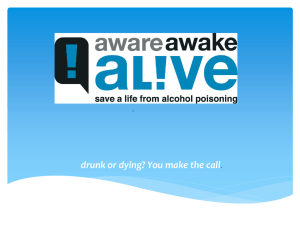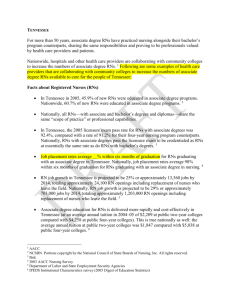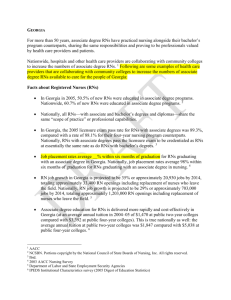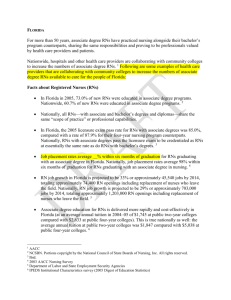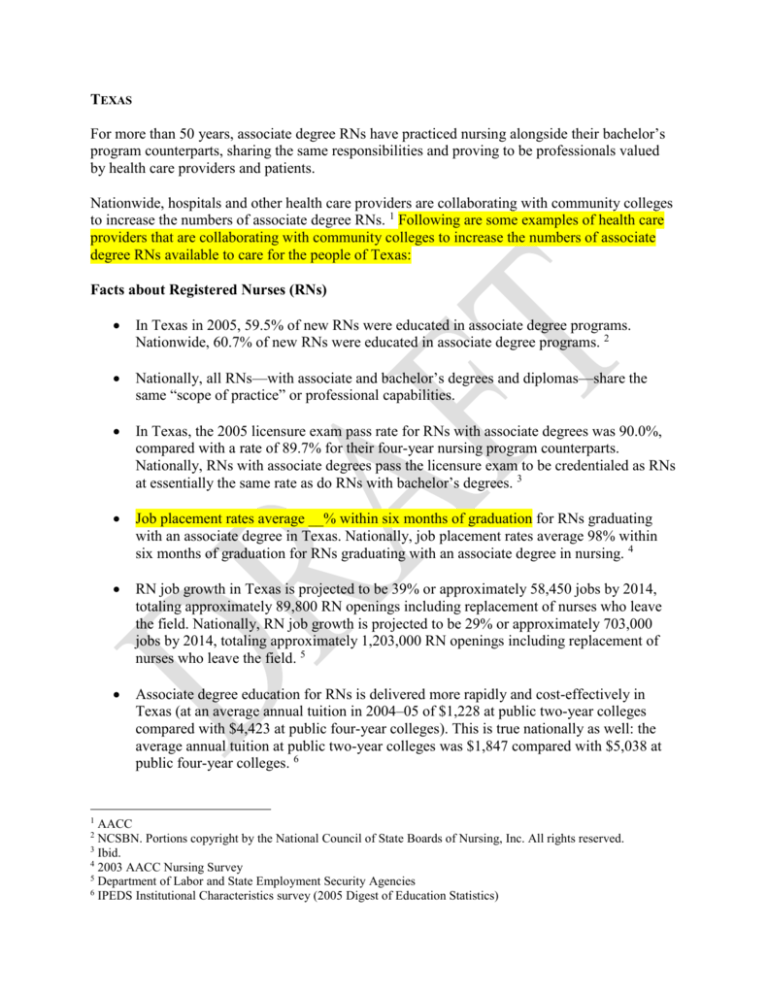
TEXAS
For more than 50 years, associate degree RNs have practiced nursing alongside their bachelor’s
program counterparts, sharing the same responsibilities and proving to be professionals valued
by health care providers and patients.
Nationwide, hospitals and other health care providers are collaborating with community colleges
to increase the numbers of associate degree RNs. 1 Following are some examples of health care
providers that are collaborating with community colleges to increase the numbers of associate
degree RNs available to care for the people of Texas:
Facts about Registered Nurses (RNs)
1
In Texas in 2005, 59.5% of new RNs were educated in associate degree programs.
Nationwide, 60.7% of new RNs were educated in associate degree programs. 2
Nationally, all RNs—with associate and bachelor’s degrees and diplomas—share the
same “scope of practice” or professional capabilities.
In Texas, the 2005 licensure exam pass rate for RNs with associate degrees was 90.0%,
compared with a rate of 89.7% for their four-year nursing program counterparts.
Nationally, RNs with associate degrees pass the licensure exam to be credentialed as RNs
at essentially the same rate as do RNs with bachelor’s degrees. 3
Job placement rates average __% within six months of graduation for RNs graduating
with an associate degree in Texas. Nationally, job placement rates average 98% within
six months of graduation for RNs graduating with an associate degree in nursing. 4
RN job growth in Texas is projected to be 39% or approximately 58,450 jobs by 2014,
totaling approximately 89,800 RN openings including replacement of nurses who leave
the field. Nationally, RN job growth is projected to be 29% or approximately 703,000
jobs by 2014, totaling approximately 1,203,000 RN openings including replacement of
nurses who leave the field. 5
Associate degree education for RNs is delivered more rapidly and cost-effectively in
Texas (at an average annual tuition in 2004–05 of $1,228 at public two-year colleges
compared with $4,423 at public four-year colleges). This is true nationally as well: the
average annual tuition at public two-year colleges was $1,847 compared with $5,038 at
public four-year colleges. 6
AACC
NCSBN. Portions copyright by the National Council of State Boards of Nursing, Inc. All rights reserved.
3
Ibid.
4
2003 AACC Nursing Survey
5
Department of Labor and State Employment Security Agencies
6
IPEDS Institutional Characteristics survey (2005 Digest of Education Statistics)
2
In 2004–05, associate degree RN programs in Texas turned away
students for each
student turned away from bachelor’s degree RN programs. Nationally, for the same year,
associate degree RN programs turned away 3.3 students for each student turned away
from bachelor’s degree RN programs. 7
Graduations from associate degree RN programs in Texas increased 3.9% between 2003–
04 and 2004–05. Nationally, graduations from associate degree RN programs increased
12.8% in that time period. 8
Associate degree RN programs are the entry point to the health professions for more
minority students in Texas and nationally. In 2004–05, associate degree RN programs
provided Texas with 1,250 new minority RNs compared with 966 provided by bachelor’s
degree RN programs. Associate degree RN programs provided America with a total of
12,907 new minority RNs compared with 9,377 provided by bachelor’s degree RN
programs. 9
RNs with associate degrees or diplomas account for
% of nurse clinicians,
% of
clinical nurse specialists,
% of head nurses, and
% of supervisors in Texas.
Nationally, RNs with associate degrees or diplomas account for 42% of nurse clinicians,
29% of clinical nurse specialists, 47% of head nurses, and 62% of supervisors. 10
Nearly
(
% or
) of RNs providing care in Long-Term Care environments in
Texas practice with the associate degree. Nationally, nearly half (46.9% or 71,860) of
RNs providing care in Long-Term Care environments practice with the associate degree.
11
7
RNs who earn associate degrees in Texas are more likely to remain and work in Texas
than are RNs who earn bachelor’s RN degrees there [Confirm that this is true].
Nationally, 74.0% of associate degree RNs practice in the state in which they were
educated, compared with 60.9% of nurses with bachelor’s degrees or higher. 12
Advanced education is directly available to associate degree RNs. As of 2006, over 160
RN to MSN (Registered Nurse to Master’s of Science in Nursing) programs in 39 states
and the District of Columbia enrolled RNs with associate degrees without requiring
bachelor’s degrees, including 10 colleges and universities in Texas:
Baylor University
Midwestern State University
Texas A&M University-Corpus Christi
Texas Christian University
Texas Woman's University
National League for Nursing and AACC preliminary 2004 nursing survey data
IPEDS 2005 Completions survey
9
Ibid.
10
HRSA 2004 National Sample Survey of Registered Nurses
11
Ibid.
12
Ibid.
8
University of Texas at El Paso
University of Texas at Tyler
University of Texas Health Science Center at Houston
University of Texas Health Science Center at San Antonio
University of the Incarnate Word 13
There were more than 150,200 licensed registered nurses (RNs) in Texas in 2000; over
126,400 were employed in nursing. There were 603.4 RNs per 100,000 population in
2000 in Texas, compared with the national rate of 780.2; Texas ranked 47th among the
states in registered nurses per capita. 14
Texas ranked 1st among the states in the number of Licensed Practical/Vocational Nurses
(LPNs) employed in 2000 with 58,860 workers. With 280.9 LPNs per 100,000
population, compared with the national rate of 240.8 per 100,000, Texas ranked 15th in
the per capita employment of LPNs. 15
Texas’s RN population dropped by
had larger declines.16
Between 1996-2000, Texas issued
RNs.17
Texas was short of 10,205 RNs in 2005. By 2015, this number will be 30,242.18
percent between 1996-2000—only
states
percent of new RN licenses to associate degree
Community Colleges are Committed to Providing the Nation with the Quality RNs it Needs
America’s community colleges have made a long-term commitment to high quality,
affordable nurse education and to the delivery of safe health care to the American public.
Community colleges are urging Congress to provide funding for an unbiased study of RN
education.
13
AACN and Discover Nursing.com (Johnson & Johnson)
HRSA State Health Workforce Profiles
15
Ibid
16
HRSA state profile or National Sample survey or State board of nursing or state survey
17
probably HRSA or NCSBN or SBON or state survey
18
HRSA Projected Supply, Demand, and Shortages of Registered Nurses: 2000-2020
14




